
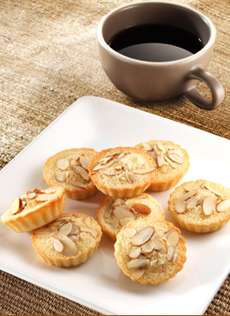 Financiers or French almond cakes were originally baked in the shape of gold bars. Find out why below. Photo courtesy of Donsuemor.com.
June 2008
Last Updated November 2025
|
 |
Types Of Cake
Cake Glossary Page 3: Terms With D, E & F
This is Page 3 of an 8-page glossary of types of cake. Click on the links below to visit the other pages, or click here to get to the Overview. After you’ve checked out the cakes, take a look at our other food glossaries—an easy way to get up to speed on more than fifty different food categories. Most related to this Cake Glossary are our Chocolate Glossary, Custard Glossary, Dessert Sauce Glossary, Ice Cream & Frozen Desserts Glossary, and Sugar Glossary.
Click on a letter to go to the appropriate glossary section.
a b c d e f g h i j k l m n o p q r s t u v w x y z
This glossary is protected by copyright and cannot be reproduced in whole or in part. You are welcome to link to it.
DEATH BY CHOCOLATE CAKE
This comprises any number of very rich chocolate cake recipes that have rich, dense chocolate layers, rich chocolate fillings—often chocolate mousse—chocolate icing, and chocolate decorations—chocolate shavings, molded chocolate, etc.
DEVIL’S FOOD CAKE and RED DEVIL’S FOOD CAKE
A rich, chocolate layer cake with chocolate frosting. The cake is made with chocolate, not cocoa; the chocolate has a much higher fat content and thus provides more richness. This is what distinguishes a devil’s food cake from a regular chocolate cake, which is typically made with cocoa powder; some recipes also contain light brown sugar. According to the Oxford Companion to Food, the cake originated in the U.S. in the 20th century (the first printed recipe is from 1905). The addition of baking soda to a regular chocolate cake recipe causes the cocoa powder to redden and hence gives the cake a red cast.
|
|
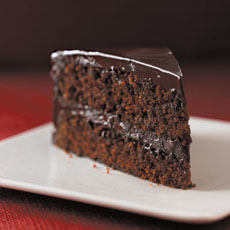
A luscious devil’s food cake recipe (photo © Nestlé | Very Best Baking). |
Such recipes, made with cocoa powder, were called “Red Devil’s Food Cake.” Often, devil’s food cake is confused with red velvet cake, also called red devil’s cake, which has a reddish color and only a mild flavor of cocoa. The two are not the same. See red velvet cake. Here’s the history of Devil’s Food Cake.
DOBOS TORTE or DOBOSH TORTE
The Dobos (pronounced Dobosh) Torte is one of Hungary’s most famous cakes, created by pastry master József C. Dobos (1847-1924) in 1884. It is a five-layer almond sponge, although some are made with six or seven layers. The sponge is moistened with rum syrup (lemon, saffron or vanilla syrup can be substituted), filled with chocolate buttercream, and topped with a layer of caramel (which helps to seal in the moisture). The buttercream-frosted sides of the cake are typically coated with crushed almonds. Historians say that the idea for a many-layered cake came from layered Middle Eastern pastries like baklava.
|
|
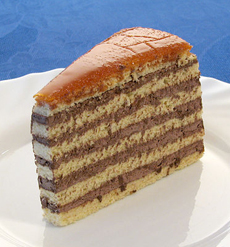
Dobos Torte. Photo by Hu Toya |
Wikimedia Commons.
|
DOUGH
Dough is a mixture of flour and liquid (water, milk, etc.) used for baking into bread or pastry. The mixture becomes thick and malleable when blended. Also, see batter.
DUMP CAKE
Popular in the South, a dump cake is a deconstructed cake, somewhat like a cobbler. A mixture of fruit, nuts, and/or jam is spread into a pan and topped with a boxed cake mix. Just by “dumping” the ingredients into the pan, you have an easy dessert. It started with canned, drained fruit (cherries, pineapple, whatever) topped by a yellow or white cake mix. Add some pats of butter on top, and when the cake comes out of the oven, it has a buttery top crust. There’s no cutting, no rolling, no mixing: Just bake at 350°F until the top is golden brown (35-40 minutes).
Its origins are tied to the convenience food movement that swept through American kitchens in the 1960s and 1970s, when packaged cake mixes, canned fruits, and other processed ingredients became widely available. It gained popularity through word-of-mouth, church cookbooks, and community recipe exchanges and became a staple at potluck dinners, church suppers, and family gatherings. It required minimal skill and preparation time.
It has been compared to the wacky cake, another 20th-century American cake that does not use eggs and which has a simple method of preparation.
|
|
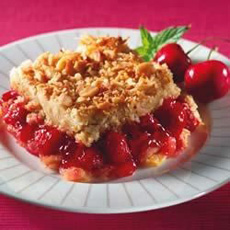
A classic dump cake made from cans of cherry pie filling and crushed pineapple. Here’s the recipe from Wilma Hunt | All Recipes.
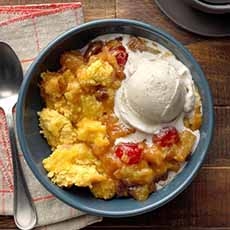
A pineapple upside-down dump cake. Here’s the recipe from Taste of Home.
|
DUNDEE CAKE
Dundee cake is a traditional Scottish fruit cake. For commercial sales, it actually has a Protected Geographical Indication (PGI) that states that the only permissible ingredients are salted butter, sugar (caster, granulated, light or dark soft brown), eggs, thick peel Seville oranges, finely grated orange zest, plain cake flour, sherry (optional), ground almonds (optional), sultanas, whole blanched almonds or split almonds. The story is that Queen Mary did not like glacé cherries, so the cake used blanched almonds instead. The top of the cake is typically decorated with concentric circles of almonds.
|
|
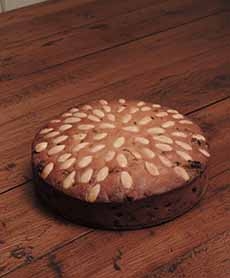 Dundee cake (photo by R. Gloucester CC BY-SA 4.0). Dundee cake (photo by R. Gloucester CC BY-SA 4.0).
|
Commercial development of the cake began in Dundee in the late 18th century, but according to legend, it was originally made for Mary, Queen of Scots, in the 16th century.
Queen Elizabeth II was reported to favour Dundee cake at teatime, and Winston Churchill was also said to be a fan.
ELECTION CAKE or HARTFORD ELECTION CAKE
A classic fruitcake or plum cake baked on Election Day. The tradition dates back to the late 1700s in Connecticut. In those days, representatives from the various towns gathered in Hartford to cast and count the votes for state offices. Election Cakes were made to serve the out-of-town lodgers. Fruit cakes were less perishable, could be made in advance, and held up through the procedures.
Why not celebrate Election Day by inviting folks for cake and coffee? Even if your candidate doesn't win, the cake will assuage your feelings.
|
|
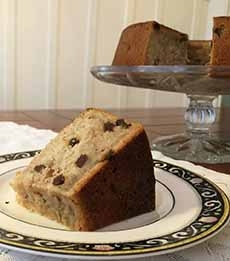
Election Cake. Here’s a recipe (both photos © Anne Ewbank | Atlas Obscura).
|
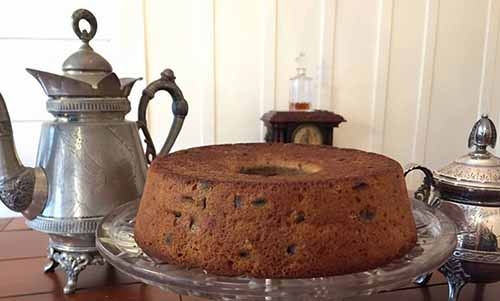
EPIPHANY CAKE or GALETTE DES ROIS
A French tradition to celebrate the feast of the Epiphany, January 6th. Puff pastry (pâte à choux) layers are filled with frangipane (almond cream), and a trinket is baked into the cake. The person who gets the slice with the trinket is named king or queen for the day. Variations of the cake include substituting brioche for puff pastry and using fillings of almond paste, chocolate ganache, or sliced apples. Bakeries sell the cake with a gold paper crown for the “king.” More about Epiphany Cake, plus a recipe.
|
|
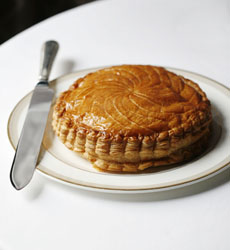
Epiphany cake. Photo courtesy
chef Hélène Darroze.
|
ESTERHAZY TORTE
A Hungarian cake named after General Ferdinand Walsin Esterhazy, a division commander in the Crimean War. Layers of buttercream and almond biscuits topped with fondant. The sides are decorated with more buttercream and sliced almonds. While the original recipe uses vanilla buttercream, chocolate is sometimes substituted.
FIG CAKE
See Spanish fig cake.
|
|
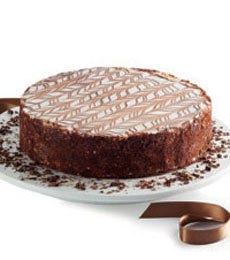
Esterhazy Torte available at
DeanDeluca.com.
|
FILLING
Layer cakes can be sandwiched with a variety of sweet fillings. Some common fillings are buttercream, cream cheese, custard ganache, jam, lemon curd, liqueur-flavored buttercream, or whipped cream (amaretto, Grand Marnier, e.g.), nut-flavored buttercream or whipped cream (hazelnut, pecan, pistachio, walnut, e.g.), and pure whipped cream.
FINANCIER
A rich French almond tea cake made from a sponge-like batter of brown butter, egg whites, flour, toasted ground almonds, and powdered sugar. Financiers were created by a baker named Lasne in the financial district of Paris in the 1890s. Named after the rich financiers who frequented his bakery, Lasne created the little unglazed cake as finger food, to be enjoyed without utensils, and to be non-crumbly—no risk to the suit, shirt, or tie of the nibbler.
Financiers were traditionally baked in the shape of gold bars, but the rectangular shape was not as attractive as other shapes.
|
|
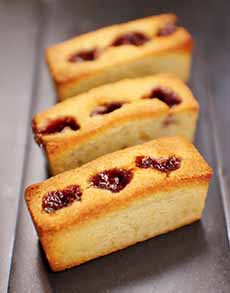
Raspberry financiers (photo © Mille Feuille Bakery | NYC). |
A boat-shaped mold became favored, and today the cake can take any shape that appeals to the baker, from octagons to the fluted circle in the photo at the top of the page. In recent years, financiers have been elevated from breakfast and tea cake to the dessert menus of fine restaurants, with a variety of elegant garnishes.
FIORI DI SICILIA
Literally, “flowers of Sicily,” Fiori di Sicilia is a very aromatic and flavorful combination of citrus and vanilla extracts. It adds a sophisticated and mysterious taste (it’s actually a very elegant variation of “creamsicle”) to pound cake, butter and sugar cookies, yellow cake, sweet bread, pie, meringues, and more. Italians use it to scent panettone and pandoro. Buy a bottle as a gift for an avid baker.
|
|
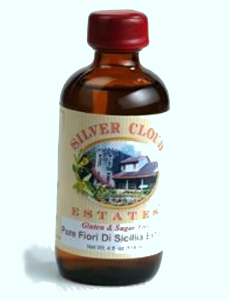
A bottle of Fiori di Sicilia. Photo courtesy Silver Cloud Estates. |
FLOUR
Different types of flour are milled for different baking purposes. Protein content and gluten content will affect elasticity. The higher the protein content, the harder the flour. Bleaching produces a lighter, more aesthetic color.
- All-purpose flour (bleached or unbleached) is a blend of hard and soft wheat and has a protein content of 10% to 11%. It is ideal for hearty cookies, like chocolate chip and oatmeal, and some pastries.
- Bread flour, made from hard wheat, has a protein content of up to 15%. It is not used for cakes but for chewy breads.
- Cake flour is made from bleached soft wheat, has a low gluten content, and has a protein content of 7% to 8%. It creates a white cake with a delicate crumb and is preferred for delicate cookies.
- Pastry flour has a moderate gluten content and a protein content of 8.5% to 9.5%. It is used for many cakes and pastries.
FLOURLESS CAKE
There are different types of flourless cakes. One substitutes ground nuts for wheat flour. While the cake does not rise as high (it is more at a level with a German torte), the cakes are just as delicious and can be enjoyed by people with gluten allergies. Angel food cake is made only of egg whites (plus sugar, cream of tartar, salt, and flavoring). Meringue cakes are also made only of egg whites, but unlike airy angel food cakes, the meringue is a hardened form.
|
|
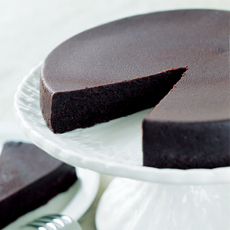
This flourless Chocolate Truffle Cake by David Glass is available at Zabars.com. |
FOAM CAKE
A category of cake that includes airy cakes with little (if any) fat and a spongy texture; for example, angel food, biscuit (the European term for sponge), chiffon, génoise, meringue, roulade, and sponge. These cakes have a high proportion of eggs to flour and no added fat, and, except for chiffon cakes, are leavened only by the air beaten into the eggs.
FONDANT (ROLLED & POURED)
Fondant is a coating for cakes that is made from sugar and water cooked to the soft-ball stage, then stirred or beaten to a creamy mass. It dries to a smooth, opaque matte finish and can be colored and/or flavored (chocolate or coffee, e.g.) or left white. It is formed into a dough, rolled out, and laid over elaborate cakes (typically wedding cakes) or petit fours. It not only gives the cakes a smooth and elegant appearance but acts as a preservative and protection: The dense fondant keeps the cake underneath moist for the extra day it may take to assemble and transport. Also, fondant does not mar easily like buttercream if it is accidentally touched.
|
|
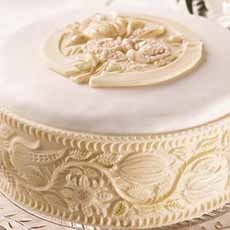
Rolled fondant covering a wedding cake (photo © King Arthur Baking). |
While some people do not care for the thickness or flavor of fondant, it should be noted that commercial fondant, bought already prepared by many cake makers, does not achieve the quality of made-from-scratch fondant (it can be flavorless and gummy). Homemade fondant can be addictively delicious, especially to people who like marshmallows (think of marshmallows made by a fine confectioner versus the dry, flavorless mass-marketed varieties). Another type of fondant, poured fondant, is very smooth and shiny and is typically used for decorating and filling cakes and pastries. There are still other types of baking fondant (such as sculpting fondant); fondant has even more, very different meanings in the world of confection. Read about them in our Chocolate Glossary.
FRAISIER
A marzipan-topped strawberry layer cake (think of it as the French version of strawberry shortcake). After the French word for strawberry, fraise, “le fraisier” is a classic French cake made with a sponge cake (génoise) base brushed with kirsch liqueur. The cake is filled with buttercream and fresh strawberries, which are generally sliced and placed to make an appealing design, and a layer of marzipan. Variations use mousseline cream instead of buttercream and Grand Marnier or other liqueur. The classic is topped with a red almond paste or Italian meringue.
|
|
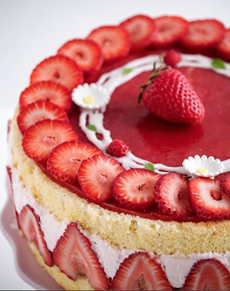
A beautiful fraisier from G Bakes. Here’s the recipe. |
FRANGIPANE or FRANGIPANI
An almond-flavored pastry cream created in the 16th century by the Marquis Frangipani, a major general under King Louis XIV. It is a thick type of crème pâtissière, mixed with powdered almonds or crushed macaroons. It is also used as a filling for tarts and crêpes. Frangipane is the French spelling, and frangipani is the Italian.
FROSTING
Frosting, used to cover the top and sides of a cake, and often as a filling between the layers, is typically made from sugar plus a fat such as butter and/or milk or cream. It is generally flavored with vanilla extract or other flavoring—cocoa powder, coffee, lemon, lime, orange, strawberry, etc. A vanilla frosting can be colored with food coloring, which adds gaiety without additional flavor. The difference between frosting and icing is that icing is made with confectioner’s sugar (also called icing sugar), but the two words are often used interchangeably.
FRUITCAKE
Fruitcakes are dense spice cakes packed with dried fruits, including raisins, and nuts. Brandy, sherry, or whiskey can be added. The forerunners of fruitcakes date back to Roman times; they evolved during the Middle Ages and became extremely popular by the 19th century, becoming the cake of choice to celebrate weddings and Christmas. Today, there is an industry in mass-produced Christmas fruitcakes with glazed dried fruits (notably, bright red and green cherries, diced citron, pineapple, orange, and lemon peel) that are unappealing, re-gifted, and have become a comedian’s joke. An artisan or homemade fruitcake, made with top ingredients, is a gourmet delight.
|
|
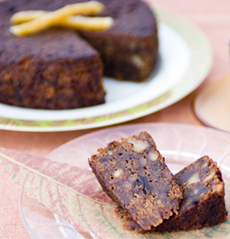
An organic fruitcake from Frog Hollow, a NIBBLE Top Pick Of The Week. Here’s the history of fruitcake. |
FUNNEL CAKE
Not a cake but a fried dough cookie topped with powdered sugar. Funnel cake is a Pennsylvania Dutch specialty that has become popular at fairs and ballparks. Funnel cake batter is basically the same as pancake batter; you can make funnel cakes using pancake mix. Whether a mix or from scratch, add some cinnamon and pour the batter through a funnel into hot oil. See the other types of cookies.
|
|
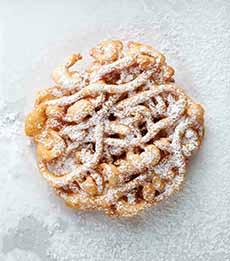
Funnel cake. Here’s the recipe (photo © Leite’s Culinaria). |
Go To The Next Page: Terms With G - K
Go To Article Index Above
Lifestyle Direct, Inc. All rights reserved. Images are the copyright of their individual owners.
|


 Financiers or French almond cakes were originally baked in the shape of gold bars. Find out why
Financiers or French almond cakes were originally baked in the shape of gold bars. Find out why 



 Dundee cake (photo by R. Gloucester CC BY-SA 4.0).
Dundee cake (photo by R. Gloucester CC BY-SA 4.0).









